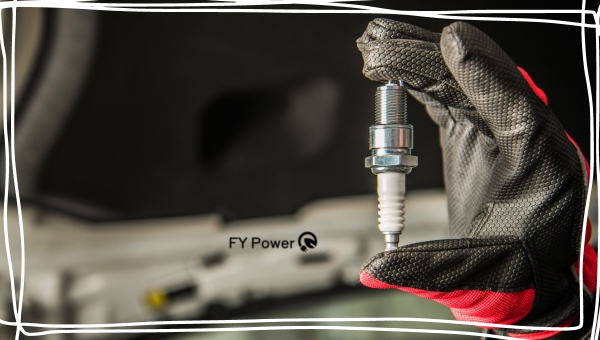Imagine being in the middle of a power outage, relying on your generator, when it suddenly sputters and dies. You’ve been diligent about the oil changes and the fuel filter replacements, but you forgot one small yet critical component – the spark plug.
Just like how a single wrong note can ruin an entire symphony, a worn-out spark plug can disrupt your generator’s performance. But don’t worry; you’re not alone in this. Many generator owners often overlook this tiny powerhouse until they face an inconvenient power failure.
This article will guide you through on how to change spark plug with ease and precision so that next time there’s a power cut, you’ll be prepared. It’s technical enough for those who love to get their hands dirty and straightforward for those who just want to keep their generators humming smoothly.
So roll up your sleeves; let’s get that generator back in tune together!
Key Takeaways
- Having necessary tools and items for changing a spark plug is important
- Safety precautions should be taken when working with power equipment
- Cleaning the area around the spark plug is important to prevent debris from falling in
- Regular maintenance of the spark plug and plug wire is important for generator longevity
Required Tools and Items
Before you get started on changing the spark plug on your generator, it’s crucial that you’ve got all the necessary tools and items handy.

The first step in this process involves gathering an essential equipment list. This includes a spark plug with the correct gap, a clean brush and towel, a spark plug socket of either 3/8′ or 5/8′, protective gloves, a ratchet, and both Phillips and flat screwdrivers. Additionally, you’ll require a spark plug gapping set to ensure optimal performance.
Taking note of tool maintenance tips is also fundamental to facilitate an efficient changeover. Regularly inspecting your tools for any signs of wear or damage will not only extend their lifespan but also guarantee safety when carrying out tasks like replacing the spark plug in your generator. For instance, always make sure your screwdrivers are free from rust that could weaken them over time.
Safety precautions should never be overlooked while dealing with power equipment such as generators. Wearing protective gloves is one way to protect yourself against potential hazards during the replacement process. Furthermore, ensuring that your work area is well-lit can help avoid mishaps associated with poor visibility.
The right preparation also means having everything within arm’s reach before embarking on this task; it eliminates unnecessary interruptions once you start working. Remember to keep all small parts in one place so they don’t get misplaced halfway through the job.
Don’t underestimate the importance of being well-prepared before tackling generator maintenance tasks like changing its spark plug. Assembling all needed gear beforehand makes for smoother operations and ensures you’re part of an empowered community taking charge of their power supply solutions!
Read: All Honda Generators Spark Plug Gap And Socket Size Guide
A Step-by-Step Guide to Change Spark Plug on Your Generator
Ready to get your hands dirty and change that spark plug on your generator?
First, you’ll need to locate the spark plug and disconnect the plug wire, ensuring everything around is clean before proceeding.

Once that’s done, remove the old plug carefully, then check the new spark plug before installation – this step-by-step guide will walk you through each detail meticulously.
Locate the spark plug
You’ll feel a surge of accomplishment once you’ve successfully located the spark plug on your generator. A part of effective generator maintenance is knowing spark plug placement. To help you visualize this, refer to the table below:
| Generator Model | Spark Plug Placement |
|---|---|
| Honda EU2000i | Left side, near the bottom |
| Yamaha EF2000iSv2 | Front panel, under a protective cover |
| Champion 46539 | Right side, near the top |
| DuroStar DS4000S | Front panel, beneath the air filter |
| WEN 56200i | Left side, under an orange cap |
Spark plug variations exist among different generator models but generally they are accessible and easy to find. Remember that being able to change your own spark plugs will deepen your sense of belonging in our community of self-reliant generator owners.
Disconnect plug wire
Next up, let’s talk about detaching the plug wire – it’s a crucial step not to be missed. Now that you’ve located the spark plug, the next move is disconnecting the plug wire. It’s where wire handling safety comes in handy.
Always remember to pull on the boot – that’s the thicker part at the end of the wire – and not on the wire itself. Yanking on it may cause damage, which can complicate your task.
Plug wire maintenance is always important; keep an eye out for any signs of wear or cracks as these might necessitate replacement. The frequency of this replacement depends on your generator usage but typically should occur every 100 hours of operation.
See? You’re becoming quite proficient at generator upkeep, ensuring its longevity while also fostering your sense of belonging within our DIY community!
Clean everything around
Before diving into the heart of the matter, it’s essential to clean everything around, just like a painter wouldn’t start on a dirty canvas. This prevents any loose debris or dirt from falling into the spark plug hole when it’s removed – keeping your generator as fit as a fiddle.
- Dirt accumulation impact: Dust and dirt can hinder performance and cause damage over time. Regular cleaning minimizes this risk.
- Generator maintenance tips: Use compressed air or a soft brush to clean off surface dust regularly.
- Cleaning frequency: Ideally, do this before every oil change or at least quarterly.
Remember, you’re not just changing your generator’s spark plug; you’re also extending its life and maintaining its optimum performance. These steps are crucial in our journey together towards mastering generator care.
Remove the old plug
Once everything’s spick and span, it’s time to tackle the task of removing the old part. Keep in mind that plug longevity varies, so knowing when to change your spark plug isn’t always clear-cut. Typically though, signs of a spark malfunction include difficulty starting your generator or reduced engine performance.
Now to start the removal process, you should locate your spark plug on the generator. It’s typically encased within a rubber boot for protection. Carefully pull this off; it’s essential not to rush as you risk damaging it.
Once removed, use a special spark plug socket wrench for loosening and extracting the old plug with utmost precision.
Remember, maintenance frequency is key here; regular checks can prevent unexpected breakdowns and keep your generator running smoothly. With practice comes familiarity—you’ll soon be part of our community of pro DIYers!
Check new spark plug
After removing the old part, it’s time to give the new one a once-over. As they say, “A stitch in time saves nine,” so make sure you’re not skipping this crucial step. Inspecting the new component can save you from future headaches.
Examine your new spark plug closely for any visible defects that could affect its performance. Check for cracks, broken insulators, or worn electrodes, as these can negatively impact plug performance and spark durability.
You’re part of a community that takes pride in doing things right, so align yourself with this ethos by avoiding installation mistakes often made by those who rush through tasks.
Remember, we’re striving for optimal generator operation and longevity here. A faulty spark plug can lead to engine misfires and reduced power output. So don’t skip this essential check before proceeding with installation; it’s all part of our shared commitment to excellence!
Read: A Guide To Yamaha Generators Spark Plug Gap and Socket Size
Install new plug
Now, let’s get down to the nitty-gritty of installing that new component. Your generator might require specific plug types, so ensure you’ve got the right one before proceeding. Begin by making a gap adjustment on your new spark plug. This is crucial for proper ignition troubleshooting.
| Steps | Instructions |
|---|---|
| 1 | Check your generator manual for the correct spark plug type and gap size. |
| 2 | Use a gapping tool to adjust the gap between the center and ground electrode. |
| 3 | Replace old spark plug with the new one, being careful not to overtighten it as it may damage the thread or ceramic insulator. |
| 4 | Reconnect high tension lead to complete installation process. |
Remember, we’re all learning together in this journey of sustaining our generators’ lifespans!
Reconnect the plug wire
In the final stretch, aren’t we? Let’s reconnect that plug wire to bring this operation full circle. Your hands-on approach in plug wire maintenance is nearly done.
Firstly, ensure your generator isn’t running; this step is critical for wire connection safety. Hold the boot at the end of the spark plug cable and gently push it onto the new spark plug until it clicks into place. This click signifies a secured connection.
If you encounter any resistance or issues when reconnecting, don’t force it! Troubleshooting wire issues might be necessary at this point. Examine if there are damages on the wire or corrosion on its connectors. If all seems well after troubleshooting, proceed with reconnection.
Remember, our shared journey doesn’t end here – regular maintenance ensures your generator’s longevity and performance.
Frequently Asked Questions
What are some common signs that my generator’s spark plug needs changing?
Imagine your generator is an athlete. If it’s misfiring, having ignition troubles or performance issues, like a runner gasping for breath, it might be time to change the spark plug – its ‘lung’.
How often should I change the spark plug on my generator?
To ensure your generator’s efficiency, follow the maintenance schedule. The plug lifespan varies, but you should change the spark plug every 100 hours of use or annually, whichever comes first. Be part of our power-secure community!
Can I use any brand of spark plug for my generator or does it need to be a specific type?
Navigating the sea of plug brands comparison isn’t rocket science. You can use any brand, but ensure it matches your generator’s specifications. Correct installation techniques and spark plug maintenance are key to a smooth running engine.
What are the potential risks if I don’t change the spark plug on my generator regularly?
Neglecting regular spark plug changes can shorten your generator’s plug lifespan, lead to ignition problems, and decrease fuel efficiency. Embrace maintenance habits to uphold your generator’s performance and secure its long-term reliability.
Can I damage my generator if I install the spark plug incorrectly?
Yes, an incorrect installation can indeed damage your generator. The consequences of spark plug misalignment are severe, impacting the generator’s performance. It’s crucial to install it right so you’re part of a well-functioning system.
Conclusion
In the grand journey of generator maintenance, you’ve now conquered spark plug replacement. Like a skilled navigator setting a new course, you’ve ensured smoother journeys ahead.
So remember, keep your tools close and this guide closer. In the vast sea of generator upkeep, let’s keep sailing smooth with regular checkups and timely replacements.
Your generator is more than a machine; it’s an ally in your power needs voyage!

